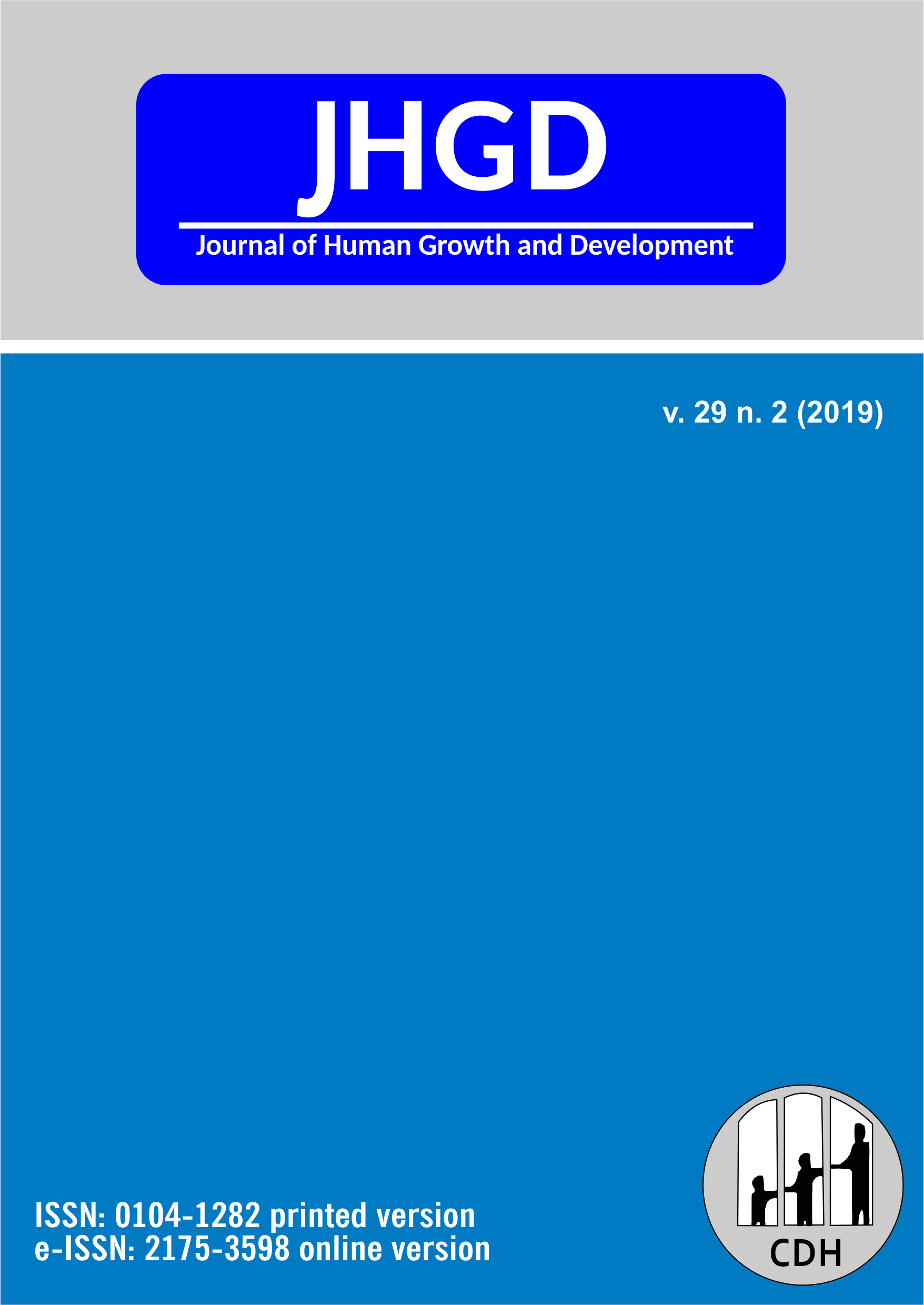Efeito do peso de objetos e da experiência na organização de tarefas de manipulação de objetos de bebês de 10 meses de idade
DOI:
https://doi.org/10.7322/jhgd.v29.9419Palavras-chave:
desenvolvimento infantil, habilidades motoras, bebêsResumo
Introdução: Pouco se sabe sobre o impacto real da prática de manipulação de objetos no desenvolvimento da percepçãoação de bebês e assume-se que esse conhecimento recémadquirido é útil para planejar ações futuras. Objetivo: O objetivo deste estudo foi investigar o efeito da prática controlada nas tarefas de alcançar e transportar objetos de crianças de 10 meses de idade quando o peso do objeto é alterado. Método: Dezesseis lactentes foram divididos em dois grupos: grupo pesado / leve (GPL) e grupo leve / pesado (GLP). A tarefa consistia em alcançar, apreender e levantar uma barra leve ou pesada por 9 tentativas. Na décima tentativa, o peso do objeto foi trocado para o objeto mais pesado ou mais leve (objeto com o peso oposto do utilizado nas 9 primeiras tentativas) para avaliar se os bebês aprenderam e adaptaram o movimento direcionado ao objeto com peso inicial da condição praticada durante as 9 primeiras tentativas. Resultados: Não foram encontradas diferenças significativas quando comparado às fases de alcance e levantamento dentro dos grupos (GPL, p= 0,41 e GLP, p= 0,06), entretanto, na comparação entre os grupos, o GPL aumentou o pico de velocidade (p= 0,01) durante as tentativas. Conclusão: Concluímos que o alcance e levantamento de objeto do bebê ao longo das tentativas é muito variável. Isso indica que, possivelmente, aos 0 meses de idade, o bebê apresenta transições de um estado organizacional para outro. No entanto, é necessário realizar investigações mais detalhadas sobre as ações de alcance e levantamento de objetos para entender os processos envolvidos nesses períodos de transição.
Referências
2. Newell KM, Jordan K. Task Constraints and Movement Organization: A Common Language. In: Davis WE. Ecological task analysis and movement. Human Kinetics, 2007; p. 5-23.
3. Hopkins B, Butterworth G. Dynamical systems approaches to the development of action. In: Bremner G, Slater A, Butterworth G. Infant development: recent advances. 1997; p. 75-100.
4. Thelen E, Smith LB. A dynamic systems approach to the development of cognition and action. Cambridge: MIT Press, 1993.
5. Rounis E, van Polanen V, Davare M. A direct effect of perception on action when grasping a cup. Scientific Rep. 2018;8:171. DOI: https://doi.org/10.1038/s41598-017-18591-5
6. Wiesen SE, Watkins RM, Needham AW. Active motor training has long-term effects on infants’ object exploration. Front Psychol. 2016;7:599. DOI: https://doi.org/10.3389/fpsyg.2016.00599
7. Libertus K, Joh AS, Needham AW. Motor training at 3 months affects object exploration 12 months later. Develop Sci. 2016;19(6):1058-66. DOI: https://doi.org/10.1111/desc.12370
8. Baumgartner HA, Oakes LM. Investigating the relation between infants’ manual activity with objects and their perception of dynamic events. Infancy. 2013;18(6):983-1006. DOI: https://doi.org/10.1111/infa.12009
9. Bourgeois KS, Khawar AW, Neal SA, Lockman JJ. Infant manual exploration of objects, surfaces, and their interrelations. Infancy. 2005;8(3):233-52. DOI: http://dx.doi.org/10.1207/s15327078in0803_3
10. Newell KM. Change in motor learning: a coordination and control perspective. Motriz. 2003;9(1):1-6.
11. Rocha NACF, Costa CSN, Savelsbergh G, Tudella E. The effect of additional weight load on infant reaching. Infant Behav Dev. 2009;32(2):234-37. DOI: https://doi.org/10.1016/j.infbeh.2008.12.012
12. Mash C. Object representation in infants’ coordination of manipulative force. Infancy. 2007;12(3):329-41. DOI: https://doi.org/10.1080/15250000701518768
13. Corbetta D, Thelen E, Johnson K. Motor constraints on the development of perceptionaction matching in infant reaching. Infant Behav Dev. 2000;23(3-4):351-74. DOI: https://doi.org/10.1016/S0163-6383(01)00049-2
14. Corbetta D, Snapp-Childs W. Seeing and touching: the role of sensory-motor experience on the development of infant reaching. Infant Behav Dev. 2009;32(1):44-58. DOI: https://doi.org/10.1016/j.infbeh.2008.10.004
15. Molina M, Jouen F. Weight perception in 12-month-old infants. Infant Behav Dev. 2003; 26(1):49-63. https://doi.org/10.1016/S0163-6383(02)00168-6
16. Mounoud P, Bower TGR. Conservation of weight in infants. Cognition. 1974;3(1):29-40. DOI: https://doi.org/10.1016/0010-0277(74)90021-3
17. Lockman JJ, Ashmead DH, Bushnell EW. The development of anticipatory hand orientation during infancy. J Exp Child Psychol. 1984;37(1):176-86. DOI: https://doi.org/10.1016/0022-0965(84)90065-1
18. Wilcox T. Object individuation: Infants’ use of shape, size, pattern, and color. Cognition. 1999;72(2):125-66. DOI: https://doi.org/10.1016/S0010-0277(99)00035-9
19. Rocha NACF, Silva FPS, Tudella E. The impact of object size and rigidity on infant reaching. Infant Behav Dev. 2006;29(2):251-61. DOI: https://doi.org/10.1016/j.infbeh.2005.12.007
20. Hesse C, Franz VH. Corrective processes in grasping after perturbations of object size. J Motor Behav. 2009;41(3):253-73. DOI: https://doi.org/10.3200/JMBR.41.3.253-273
21. Corbetta D, Thelen E. A method for identifying the initiation of reaching movements in natural prehension. J Motor Behav. 1995;27(3):285-93. DOI: http://dx.doi.org/10.1080/00222895.1995.9941718
22. Thelen E, Corbetta D, Spencer JP. Development of reaching during the first year: role of movement speed. J Exp Psychol Hum Percept Perform.1996;22(5):1059-76. DOI: http://dx.doi.org/10.1037/0096-1523.22.5.1059
23. Gordon AM, Fossberg H. Development of neural mechanisms underlying grasping in children. In: Neurophysiology and neuropsychology of motor development. London: Mac Keith and Cambridge University, 1997; p. 214-31.
24. van der Kamp J, Savelsbergh G. Action and perception in infancy. Infant Behav Dev. 2000;23(3-4):237-51. DOI: https://doi.org/10.1016/S0163-6383(01)00071-6
25. Van der Fits IB, Otten E, Klip AW, Van Eykern LA, Hadders-Algra M. The development of postural adjustments during reaching in 6- to 18-month-old infants. Evidence for two transitions. Exp Brain Res. 1999;126(4):517-28. DOI: https://doi.org/10.1203/00006450-199907000-00001
26. Guimarães EL, Tudella E. Immediate effect of training at the onset of reaching in preterm infants: randomized clinical trial. J Mot Behav. 2015;47(6):535-49. DOI: https://doi.org/10.1080/00222895.2015.1022247
27. Elman JL, Bates EA, Johnson MH, Karmiloff-Smith A, Parisi D, Plunkett K. Neural network modeling and connectionism. Rethinking innateness: a connectionist perspective on development. Cambridge: The MIT Press, 1996.
28. Plumert JM, Spencer JP. The emerging spatial mind. Oxford, UK: Oxford University Press, 2007.
29. Thelen E, Smith LB. A dynamical systems approach to the development of perception and action. Cambridge: MIT Press, 1994.







